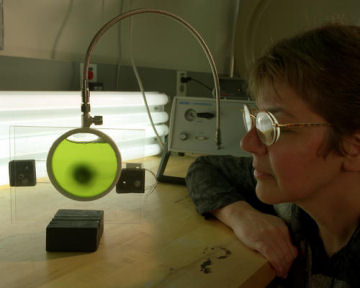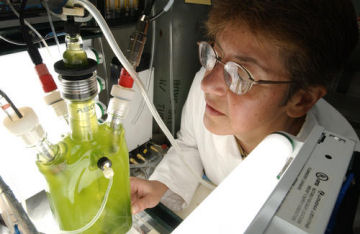Catching some rays
In a world with increasing energy needs, scientists are turning to plants for help in using solar power.
By Sarah Webb
Harnessing the power of the sun is nothing new. People have had solar-powered calculators and buildings with solar panels for decades. But plants are the real experts: They’ve been using sunlight as an energy source for billions of years.
Cells in the green leaves of plants work like tiny factories to convert sunlight, carbon dioxide, and water into sugars and starches—stored energy that the plants can use. This conversion process is called photosynthesis. Unfortunately, unless you’re a plant, it’s difficult and expensive to convert sunlight into storable energy. That’s why scientists are taking a closer look at exactly how plants do it.
 |
|
Plants such as this sunflower efficiently convert the sun’s light into energy that they can use.
|
| iStockphoto.com |
In a world with increasing energy needs, researchers are always looking for new ways to power everything from cars to computers without putting more stress on the environment. That’s another reason why scientists are so interested in solar power—it doesn’t pollute the air, water, or land. And since the sun lights and warms the entire planet, the ability to harness its energy could provide a clean energy source for everyone.
Focusing on fuel
The main sources of energy that people use today are called fossil fuels, such as natural gas, oil, and coal. Unfortunately, the supply of fossil fuel is limited. Once we use all the coal and oil in the Earth, they’re gone for good. The sun, on the other hand, is a renewable energy source. No matter how we tap it for energy, the sun will be around—at least for the next few billion years.
There’s another problem with burning fossil fuels—pollution. The ideal energy sources of the future will be “clean”: they won’t produce carbon dioxide and other gases that pollute the environment as fossil fuels do.
 |
|
The air pollutants spewed by this oil refinery illustrate one drawback to relying on energy from fossil fuels.
|
| iStockphoto.com |
Hydrogen is one alternative to fossil fuels that interests many researchers today. Hydrogen burns clean—it produces only water, not carbon dioxide. Researchers are trying to come up with ways to make large quantities of hydrogen cheaply and cleanly, and one way involves using plants or plant-like organisms, such as algae.
Putting plants to work
Some scientists are trying to get plants, or biological cells that act like plants, to work as miniature photosynthetic power stations. For example, Maria Ghirardi of the National Renewable Energy Laboratory in Golden, Colo., is working with green algae. She’s trying to trick them into producing hydrogen instead of sugars when they perform photosynthesis. Once the researchers can get the algae working efficiently, the hydrogen that they produce could be used to power fuel cells in cars or to generate electricity.
 |
|
The algae (green) are grown in flasks to produce hydrogen in the lab.
|
| Courtesy of DOE/NREL, Warren Gretz |
During photosynthesis, plants normally make sugars or starches. “But under certain conditions, a lot of algae are able to use the sunlight energy not to store starch, but to make hydrogen.” Ghirardi says. For example, algae will produce hydrogen in an airfree environment. It’s the oxygen in the air that prevents algae from making hydrogen most of the time.
Working in an airfree environment, however, is difficult. It’s not a practical way to produce cheap energy. But Ghirardi and her colleagues have discovered that by removing a chemical called sulfate from the environment that the algae grow in, they will make hydrogen instead of sugars, even when air is present.
Unfortunately, removing the sulfate also makes the algae’s cells work very slowly, and not much hydrogen is produced. Still, the researchers see this as a first step in their goal to produce hydrogen efficiently from algae. With more work, they may be able to speed the cells’ activity and produce larger quantities of hydrogen.
 |
|
Maria Ghirardi observes one of her algae reactors.
|
| Courtesy of DOE/NREL, Warren Gretz |
The researchers hope that algae will one day be an easy-to-use fuel source. The organisms are cheap to get and to feed, Ghirardi says, and they can grow almost anywhere: “You can grow them in a reactor, in a pond. You can grow them in the ocean. There’s a lot of flexibility in how you can use these organisms.”
Making sun catchers from scratch
Other scientists interested in alternate fuel sources are also focusing on plants. But these researchers want to re-create what plants do without actually using them.
 |
|
Plants have molecules that catch and store solar energy. Scientists want to create molecules that mimic what plant molecules do.
|
| iStockphoto.com |
Plants have specific molecules that catch the energy of sunlight during photosynthesis. Some biochemists have used special techniques to take a snapshot of these molecules inside a cell. “We finally know what the little factory looks like,” says Daniel Nocera, a professor of chemistry at the Massachusetts Institute of Technology (MIT).
Chemists in Nocera’s lab have an ambitious plan to capture the sun’s energy. Instead of tweaking the sun-catching molecules found naturally in plants and algae, these researchers want to build artificial sun-catching molecules from scratch. “We’re all busily working away to try to figure out how to make [photosynthesis] happen outside of the leaf,” Nocera says.
Their goal—even though it is still many years away—is to have the artificial molecules produce hydrogen for everyday use.
 |
|
Sunlight is already Earth’s chief energy source. If humans can learn to harness solar energy more efficiently, sunlight will provide even more energy than it does now.
|
| iStockphoto.com |
Finding solutions to our energy problems is one of the great scientific challenges of our time, Nocera says. But it’s the challenge of the unanswered questions that keeps him excited about his work. “It’s like we need to paint a picture,” he says. “At some points, we don’t even have the paints yet.”
Going Deeper:







